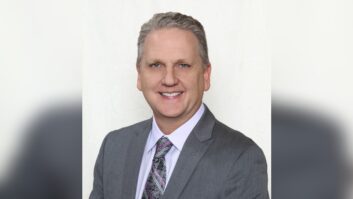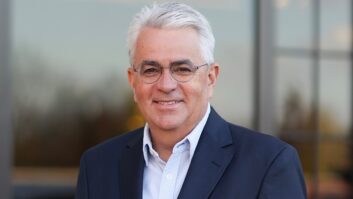
WDTW’s tower with above-ground radials.
AM RF transmission technology has long been well-understood and doesn’t ever seem to change — antenna and radials in the ground, right? Mike Vanhooser, president, Nova Electronics, offers a different approach.
Radio World: Who are you and what is your radio engineering experience?
Mike Vanhooser: I first discovered radio when I was about 5, and had an AM radio in my room, where I would listen to it after my parents were asleep. Late one night in the early ’60s I tuned across 1570 kHz and heard the booming music and growl of Wolfman Jack on XERF. From that moment I knew radio would be my life. At 15 my parents sent me to military school. Luckily, my roommate was another radio nerd. We built a 10 W AM transmitter and put our pirate station on the air from our dorm room. Both of us are still engineering radio today. I have been chief engineer of some of the biggest stations in Texas, and have been in business as Nova Electronics, building and engineering stations, for almost 30 years. So far I have been at broadcast engineering for 48 years, and I’m starting to catch on.
RW: You’ve developed a specialty — what is an elevated counterpoise?
Vanhooser: Think of an amateur or CB “Ground Plane” antenna, a vertical driven radiator with four horizontal elements or radials. The only difference is the size. The traditional buried counterpoise system requires 120 radials due to earth losses. When you take four–six radials and elevate them about 15–20 feet (0.02λ), you overcome the earth losses and have a virtually identical radiating antenna. Numerous installations have shown equal to superior stability to a buried system, as earth losses rarely change with soil moisture levels.
RW: Why would/should a station contemplate such a thing?
Vanhooser: There are a number of reasons. You could be in an area with rocky or muddy soil, either of which will make plowing difficult; maybe an environmentally-sensitive area, heavily wooded/brushy areas, productive farmland, or even on top of a mall. Also, an elevated counterpoise is drastically cheaper and easier to install than a buried system, and makes theft/vandalism less likely and easier to repair, if it happens.
RW: Are there any downsides? Any possible trouble from the FCC?
Vanhooser: Not really. The FCC approved them many years ago, thanks to the pioneering efforts of Clarence Beverage. The only downside, at the moment, is that you can’t do a Method of Moments proof with them. However, the primary reason is that there isn’t any modeling software written for it. Once that happens (Calling all programmers!), then there isn’t a drawback. But until then, the added cost of running a conventional proof is offset by the saving on the elevated counterpoise.
RW: How much does this cost and how long does it take? Are there any successful projects using this technology?
Vanhooser: It’s roughly about one-quarter the material cost and time of a conventional buried system. On the six-tower array of WDTW(AM) in Detroit, the elevated counterpoise took 7,000 feet of wire at a cost of just under $2,000. A conventional system would have taken 20 miles of wire at a cost of over $10,000, and about two weeks (under ideal conditions) to install. This one took three days. A standard nondirectional tower would run about $2,500–$3,000 and take about a day.
Both Clarence Beverage and myself have built numerous systems around the country, and all perform as well, if not slightly better, than a buried system. These stations include WDTW, WPCI, KXKW, WNJO, WGNY, WWJZ, WVNJ and KNGR. The elevated counterpoise, while dating back over 80 years, is just now being implemented into the broadcast world, and with outstanding results. Once the MoM modeling is developed, I see many stations adopting this system for its multitude of benefits.












